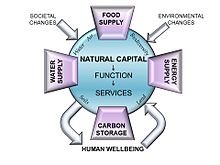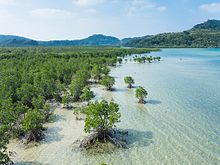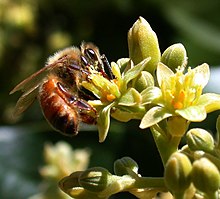自然财富
自然财富,又名自然资本等,是自然资源的基础。当中包括地质、土壤、空气、水和各种生物。部分自然财富提供免费物品或服务,常称为生态系统服务。[2][3]。

自然财富是经济学上资本的延伸,以表示自然界中能作更多生产的资源,例如受合适保护的树林或河流可长时间提供木材及鱼类。自然财富亦会提供侵蚀控制和传粉等服务,而相对则需要保持健康的生态环境和生物多样性[4]。自然财富对现时以及未来的人类健康或经济都会有深远影响,而自然财富检查则是一种供管理者理解此类影响的方法[5]。
历史
编辑自然财富(Natural capital)一词于1973年由E·F·舒马赫于其所著的《微少即美丽》中首次使用[6],并由赫尔曼·E·戴利等人将其扩展,以补足传统的经济理论[7][8]。自然财富是生态系统估价的重要一环,后者认为其他生命为人类提供不可或缺的商品或服务,故自然财富为经济可持续性的必需品。
传统生产因素经济分析会将自然财富归类为“土地”而非“资本”,乔治主义等理论认为前者为固定供应,后者则只包括人造物[9][10]。然而,“土地”并非一成不变,而是会于长年累月下改善或劣化。而现时,生态学家与经济学家一同测量并计算生态系统的价值,并由此寻找生物多样性危机的解决方法[11][12][13]。 部分研究者尝试为生态系统服务配上相应的商业价格,例如加拿大的北方针叶林不受损毁时价值约3.7万亿美元,而该森林比其他生物群系储存了更多碳[14]。北方针叶林每年产出约932亿美元的生态系统服务,为资源产出的2.5倍之多。1997年的计算中,17个生态系统的总经济价值为每年33万亿美元[15]。这类生态经济价值不会计算入国民收入或国内生产总值,因其通常不会进入国际市场之内[16][17]。自然财富于近代一直加速损失,然而一般未被发现又或被主流分析所忽略[18]。
国际层面中自然财富的基本原则已获多数承认,但如何有效评估生态健康、资本及服务值则存在不确定性。环境完全成本会计建议将生态赤字或自然赤字与经济或社会赤字并列。然而,此类赤字难以计价及审计,特别是空气或水等全球性资源难以评估[19]。
自然财富的概念亦用于生物圈二号计划以及自然资本主义之中。近年亦有用于政治界之中。
《自然资本主义:创造下一场工业革命》一书指“下一场工业革命”须围绕四项基本策略才会发生:依靠更高效率的制造过程减少资源损耗、重用自然系统中的物料、将价值由数量改为质素以及投资于自然财富当中[20][21]。
自然财富宣言
编辑2012年6月联合国可持续发展会议中提出了自然财富宣言,由40位首席执行官签署以“推动于借贷、股票、固定收入、保险产品以及会计、披露和报告中加入自然财富的考虑”。他们将支持各类团体发展工具和制度以将自然财富的理念融入现有金融架构中[22] 。
自然财富协定
编辑2016年7月,自然财富联盟发表自然财富协定[23]。当中提供标准化框架以便机构辨识、量度和估算他们对自然财富的直接和间接依存和影响。协定亦协调现有的工具和方法,以为各机构提供策略或行动决策的自然财富指引[24]。
国际认可标准
编辑环境经济会计提供了环境与经济关连的综合统计框架,包括经济对环境的影响以及环境对经济的贡献。当中的指标包括:
环境经济会计系统(System of Environmental-Economic Accounting)包含了国际认可的的标准概含、定义、分类、会计原则以及环境与经济关系的表格。此系统富有弹性以容许各国因应个别情况作改变。联合国环境经济会计专家委员会(UN Committee of Experts on Environmental-Economic Accounting)为系统的实行作协调,亦有持续发展新方法,并于2014年公布正式环境经济会计系统中央框架。
批评
编辑虽然量度自然财富的组成较为简单,但为其配以合适的金钱价值则甚为困难,特别是某些原为免费的资源和服务经常引起争论[25]。英国卫报专栏批判了政府的自然财富委员会以及其他人为自然财富打上金钱标签的行为[26]。其他人则指为自然财富估价并融入至决策当中可为环境抵抗部分商业压力,而估价本身并非货币化[27][28]。
参见
编辑参考资料
编辑脚注
编辑- ^ Valiela, Ivan; Bowen, Jennifer L.; York, Joanna K. Mangrove Forests: One of the World's Threatened Major Tropical Environments. BioScience. 2001, 51 (10): 807–815 [2016-01-05]. ISSN 1525-3244. doi:10.1641/0006-3568(2001)051[0807:mfootw]2.0.co;2. (原始内容存档于2016-12-13).
- ^ What is natural capital?. naturalcapitalforum.com. World Forum on Natural Capital. [31 December 2015]. (原始内容存档于2019-10-06).
- ^ What is Natural Capital. www.naturalcapitalcoalition.org. Natural Capital Coalition. [31 December 2015]. (原始内容存档于2016-06-02).
- ^ Search - The Encyclopedia of Earth. www.eoearth.org. [2020-09-06]. (原始内容存档于2013-05-27).
- ^ UK NEAFO Work Package 1: Natural capital asset check – Annex 4: Case studies. uknea.unep-wcmc.org. UK National Ecosystem Assessment: 3. [31 December 2015]. (原始内容存档于2016-01-02).
- ^ Schumacher, E.F. Small is Beautiful: A Study of Economics As If People Mattered. 1973.
- ^ COSTANZA, ROBERT; DALY, HERMAN E. Natural Capital and Sustainable Development. Conservation Biology. March 1992, 6 (1): 37–46. ISSN 0888-8892. doi:10.1046/j.1523-1739.1992.610037.x.
- ^ Farber, Stephen. An Introduction to Ecological Economics. Edited by Robert Costanza, John Cumberland, Herman Daly, Robert Goodland and Richard Norgaard, St. Lucie Press. 1997, pp. 288.. Ecological Economics. June 1999, 29 (3): 488–490. ISBN 1884015727. ISSN 0921-8009. doi:10.1016/s0921-8009(99)00029-4.
- ^ [1] (页面存档备份,存于互联网档案馆) - Progress and Poverty by 亨利·乔治, Chapter 2.
- ^ Economic Definitions. www.henrygeorge.org. [2020-09-06]. (原始内容存档于2019-04-10).
- ^ Edwards, P. J.; Abivardi, C. The value of biodiversity: Where ecology and economy blend. Biological Conservation. 1998, 83 (2): 239–246. doi:10.1016/S0006-3207(97)00141-9.
- ^ Naidoo, R.; Malcolm, T.; Tomasek, A. Economic benefits of standing forests in highland areas of Borneo: quantification and policy impacts (PDF). Conservation Letters. 2009, 2: 35–44 [2010-12-20]. doi:10.1111/j.1755-263x.2008.00041.x. (原始内容 (PDF)存档于2011-09-04).
- ^ Zhoua, X.; Al-Kaisib, M.; Helmers, M. J. Cost effectiveness of conservation practices in controlling water erosion in Iowa. Soil and Tillage Research. 2009, 106 (1): 71–8. doi:10.1016/j.still.2009.09.015.
- ^ Jonsson, M.; Wardle, D. A. Structural equation modelling reveals plant-community drivers of carbon storage in boreal forest ecosystems. Biology Letters. 2009, 6 (1): 1–4. PMC 2817262 . PMID 19755530. doi:10.1098/rsbl.2009.0613.
- ^ Costanza, R.; et al. The value of the world's ecosystem services and natural capital. (PDF). Nature. 1997, 387 (6630): 253–260. Bibcode:1997Natur.387..253C. doi:10.1038/387253a0. (原始内容 (PDF)存档于2009-12-26).
- ^ Ferguson, K. The True Value of Forests. Frontiers in Ecology and the Environment. 2006, 4 (9): 456. JSTOR 3868812. doi:10.1890/1540-9295(2006)4[452:D]2.0.CO;2.
- ^ Anielski, M.; Wilson, S. Counting Canada's Natural Capital: Assessing the Real value of Canada's Boreal Ecosystems (PDF). Can. Bor. Ini., Pembina Institute, Ottawa. 2005. (原始内容 (PDF)存档于2005-12-07).
- ^ Wakernagel, M.; Rees, W. E. Perceptual and structural barriers to investing in natural capital: Economics from an ecological footprint perspective.. Ecological Economics. 1997, 20 (1): 3–24. doi:10.1016/S0921-8009(96)00077-8.
- ^ Sustainability Pathways: Full-cost accounting. www.fao.org. [2020-03-10]. (原始内容存档于2019-09-21).
- ^ Hawken, Paul; Amory Lovins; Hunter Lovins. Natural Capitalism: Creating the Next Industrial Revolution. 1999.
- ^ Book Review: Natural Capitalism. Social Funds. [2009-04]. (原始内容存档于2010-01-03).
- ^ Natural Capital Declaration. www.naturalcapitaldeclaration.org. [5 January 2016]. (原始内容存档于8 December 2015).
- ^ Log In ‹ Natural Capital Coalition — WordPress. naturalcapitalcoalition.org.[失效链接]
- ^ Natural Capital Coalition - Protocol. naturalcapitalcoalition.org. [2020-09-06]. (原始内容存档于2016-08-26).
- ^ Conniff, Richard. What's Wrong with Putting a Price on Nature?. e360.yale.edu. Yale University. 18 October 2012 [5 January 2016]. (原始内容存档于2016-12-13).
- ^ Monbiot, George. Put a price on nature? We must stop this neoliberal road to ruin. The Guardian. 24 July 2014 [5 January 2016]. (原始内容存档于2021-05-06).
- ^ Paddison, Laura. Is natural capital a 'neoliberal road to ruin'?- experts discuss. The Guardian. 1 August 2014 [5 January 2016]. (原始内容存档于2021-04-25).
- ^ Natural Capital (Does putting a value on natural capital mean it will be 'sold off'?). www.naturalcapitalcommittee.org. Natural Capital Committee. [5 January 2016]. (原始内容存档于13 January 2016).
延伸阅读
编辑- Pearce, D. 1993. Blueprint 3: Measuring Sustainable Development. Earthscan. ISBN 1-85383-183-2
- Jansson, AnnMari; et al. (1994). Investing in Natural Capital : The Ecological Economics Approach to Sustainability. Washington, D.C.: Island Press, 504 pp. ISBN 1-55963-316-6.
- Daily, Gretchen C. (editor) (1997). Nature's Services: Societal Dependence on Natural Ecosystems. Washington, D.C.: Island Press, 392 pp. ISBN 1-55963-476-6.
- Prugh, Thomas; Robert Costanza et al. (1999). Natural capital and human economic survival. Solomons, Md.: International Society for Ecological Economics, 180 pp. ISBN 1-56670-398-0.
- Helm, Dieter (2015). Natural Capital - Valuing Our Planet. Yale University Press; 277 pp. ISBN 978-0-300-21098-9
外部链接
编辑- Costanza, Robert (Lead Author); Cutler J. Cleveland (Topic Editor). 2008. "Natural capital." (页面存档备份,存于互联网档案馆) In: Encyclopedia of Earth. Eds. Cutler J. Cleveland (Washington, D.C.: Environmental Information Coalition, National Council for Science and the Environment). First published in the Encyclopedia of Earth February 26, 2007; Last revised July 31, 2008; Retrieved September 5, 2008.
- Earth Economics Natural Capital Accounting Solutions Article [2] (页面存档备份,存于互联网档案馆)
- Natural Capital Project. A joint venture among The Woods Institute for the Environment at 史丹佛大学, The Nature Conservancy, 世界自然基金会.
- NOAA Economics US Economic Benefits of Natural Systems to Business and Society.
- Ecosystem Valuation Toolkit [3]
- Lacombe Morgane and Aronson James, 2009. Restoring Natural Capital in Arid and Semiarid Regions Combining Ecosystem Health with Human Wellbeing (页面存档备份,存于互联网档案馆). Les dossiers thématiques du CSFD. N° 7.
- Earth Economics [4] (页面存档备份,存于互联网档案馆)
- http://unstats.un.org/unsd/envaccounting/seea.asp (页面存档备份,存于互联网档案馆) System of Environmental-Economic Accounting (SEEA)
- http://www.naturalcapitalcoalition.com[永久失效链接]
- http://naturalcapitalforum.com (页面存档备份,存于互联网档案馆) in 2015
- http://teebweb.org (页面存档备份,存于互联网档案馆) The Economics of Ecosystems and Biodiversity (TEEB)
- https://web.archive.org/web/20150426071137/http://unstats.un.org/unsd/envaccounting/White_cover.pdf SEEA Central Framework
- https://web.archive.org/web/20160909034301/http://envisionation.co.uk/index.php/blogs/nick-breeze-blogs/151-partha-dasgupta-natural-capital Nick Breeze Interview with Economist Sir Partha Dasgupta, "What is Natural Capital?"

